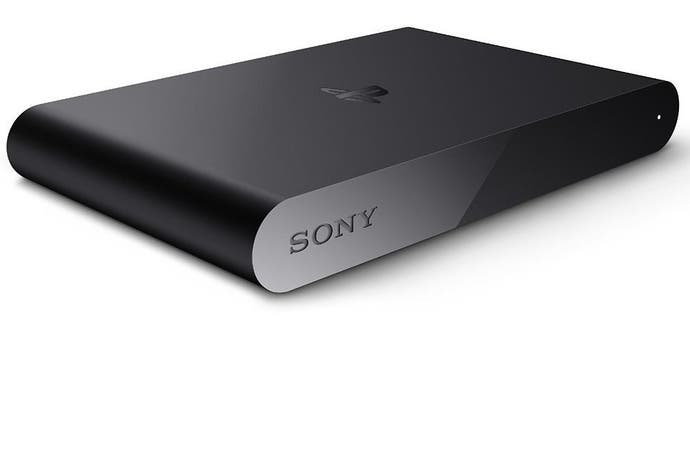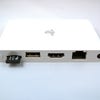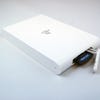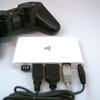Hands-on with PlayStation TV Remote Play
From the archive: Digital Foundry's in-depth assessment of Sony's micro-console game streaming functionality.
Re-published today to accompany our review of the UK version of the PlayStation TV, this Digital Foundry article was originally set live on June 20th, earlier this year. This week, we re-tested Remote Play functionality as part of the review process. A lower quality video option has been introduced (which we suspect is to help for streaming over the internet) but otherwise PlayStation TV's Remote Play feature-set and performance remain unchanged.
Months after its Japanese debut, Vita TV is finally set to arrive in the west later this year, renamed PlayStation TV and repositioned as an 'on-ramp' for developers entering Sony's video gaming ecosystem. Sony's E3 messaging suggests that the era of AAA development and exclusive Vita titles may be drawing to a close, so what takes their place in addition to the indie loveliness? Well, the platform's also being marketed as an extender for the PlayStation 4, as Sony Computer Entertainment boss Andrew House told Gamasutra at E3:
"We've taken a more holistic view with our platforms," House said. "With Remote Play, Vita has now essentially become an extender or an enhancer for the main platform for other rooms in the house, or when someone else wants to use the main screen."
We've already looked at the handheld Vita's Remote Play credentials back at the launch of PS4. Our verdict at the time? Image quality takes a hit but is generally OK on the small screen, but the latency is palpable to the point where controls on certain games just don't feel right any more. So how does this translate to the PlayStation TV Remote Play experience? Funny you should ask.
A few weeks back, Sony upgraded the firmware of the Japanese Vita TV, finally allowing for full Remote Play functionality and giving us the chance to preview how well the hardware works as a PS4 extender. Short of Sony completely redesigning the device's internals or significantly upgrading the software, the experience you have when the device ships in the US and Europe should be the same that we have in our offices right now with the Japanese kit.
Not surprisingly, the Remote Play set-up process is almost completely identical on PlayStation TV and standard Vita. The front-end is a complete match with the handheld, just with DualShock controls taking over from touch. The recent firmware upgrade adds the essential PS4Link option, and from there it's simplicity itself to access your PS4. PlayStation TV itself supports both DualShock 3 and DualShock 4 controllers, either wired or wireless. Another cool feature is that two pads can be connected at once with access to two different PS4 accounts - useful if you're remotely streaming split-screen games, for example.
"Sony's knack for making beautiful hardware extends to PlayStation TV - this is the coolest, most well-designed micro-console available."
- Order the PlayStation TV from Amazon with free shipping
In theory PlayStation TV offers a couple of key benefits over the handheld version: the full 720p video stream beamed over from the PS4 is rendered on-screen without any downscaling, and PlayStation TV features an integrated ethernet port, allowing for a wired connection between home console and extender, via the router. Perhaps this could help address our latency concerns? On the flipside, if image quality was occasionally iffy on a five-inch screen, how would it stand up on a full-on HDTV?
First of all, it's important to the put the underlying technology into context. The PS4 appears to be beaming its existing, shareable background media stream over to the PlayStation TV, so we're looking at h.264 video at around 5mbps. This video compression standard was designed for transmitting movies and TV content in a bandwidth-efficient manner, so there's no real surprise here - post-processed, softer imagery works better than typical high-frequency detail game visuals.
In typical living room conditions, Watch Dogs still looks good - even with the 720p downscale - but games with more intense detail (Killzone, Call of Duty: Ghosts), can suffer badly with terrifically obvious and somewhat off-putting macroblocking in fast-moving scenes. The only way to mitigate the effects of this is to sit further away.
Perhaps more noticeable is the frame-rate drop to 30fps. For 60fps titles like Trials Fusion, Battlefield 4 and Call of Duty, the drop in fidelity is obvious, but frame-pacing is also an issue, and even then, consistency in frame delivery remains an issue over WiFi in direct connect mode, and the overall experience is much improved by switching to a wired LAN set-up - something we will come back to a bit later.
"Video compression tech is built for movies and TV shows. At the low bitrates PlayStation TV has to work with, high-detail gaming visuals are often visibly compromised."
We wanted to get a firm lock on the baseline latencies that gameplay streaming adds to input lag, and the fact both PS4 and PlayStation TV output HDMI signals allows us to hone our testing methodology. To begin with, we connected both devices to an Asus PQ321Q 4K monitor, allowing us to run both streams side by side in its picture-by-picture mode. We ran the PS4 at 720p resolution in order to match the amount of processing the display would need to do on the PlayStation TV signal, then filmed the screen with a high-speed camera at 120fps.
We then looked at the footage and counted how many frames it took for the exact same frame to render first on PS4 before it appeared on PlayStation TV. The result? With a direct WiFi connection, a disappointing 100ms to 116ms latency, with an occasional spike to 150ms. Remember, that's in addition to the game's inherent input lag and the latency in your display.
Next, we tried a second approach - we hooked up two high-end capture cards to our PC, using Open Broadcasting Software to composite the two images into the same stream, and captured that. The same tests produced the same results - 100ms to 116ms delay between the exact same frame displayed on PS4 making its way via WiFi to the Vita - and the same occasional lurches in refresh.
With two entirely different measurement methodologies in place producing the exact same results, we stuck with the OBS approach for further testing, mostly because direct-feed assets are of a much higher quality than filmed footage, allowing us to produce the video below without any intrusive ghosting. We've run it at 50 per cent speed - if YouTube's HTML5 player is active in your browser, you should be able to run it at 2x speed for a full real-time experience.
"We note a baseline latency of 100ms that's added by Remote Play streaming - and that's on top of input lag and display latencies."
Next up, we looked into getting the best Remote Play experience we could. There are a number of different connection techniques available - the direct connection between PS4 and Vita hardware (only really of use if you're in the vicinity of the console), along with WiFi and LAN hook-ups between PS4, router and the extender. To put these varying techniques to the test, we captured the same scene from Call of Duty: Ghosts.
The results were enlightening - while we could drop frames at any given point on any connection type, a pattern began to form. Firstly, the direct connection between extender and PS4 may seem like the best option, but in our tests it had the biggest impact on overall consistency. Connecting the PS4 to your router via a LAN cable, then allowing the Vita hardware to interface via WiFi sees significant improvement here.
Finally, we had a breakthrough of sorts. Using the same router we attached PlayStation TV via ethernet, giving a full, wired connection between both devices. We won't lie to you, latency is still clearly in evidence, but this is obviously the preferred way to utilise Remote Play. Killzone Shadow Fall and Watch Dogs gained a new level of response we hadn't experienced previously, and we could progress through both games without feeling that the lag was massively intrusive.
Here's the interesting aspect though - re-running the latency test to measure the amount of time between the same frame being rendered on PS4 and PlayStation TV still produces a lacklustre six-frame deficit: 100ms. The difference is that the lurches in response are significantly reduced. Moving from a wireless to a wired connection simply gives us the fastest speed possible from the hardware and consistency in the transmission and reception of data.
"PlayStation TV's LAN port gives it an advantage over the Vita handhelds - removing WiFi from the equation produces an improved, more consistent Remote Play experience."
Our advice for the best Remote Play experience? Steer clear of the Vita direct-connection method - two sets of WiFi devices in the mix isn't good for consistency. Always connect up your PS4 to your router via a LAN cable and utilise WiFi for your Vita and PlayStation TV. If you can - and we appreciate that this is only applicable to a small minority - stick to a cabled set-up for the best results. Switching from the DualShock 3 to its PS4 successor also helped a great deal. Obviously baseline latencies aren't going to change, but the exercise was enormously instructive in demonstrating just how much improvement there is in the analogue stick deadzones on the new pad and how this genuinely improves response.
PlayStation TV - is Remote Play good enough?
It looks as though there has been some refinement of PS4 Remote Play since we initially looked at it in the launch period - the occasional picture break-up we saw back then on both first and second-gen Vitas has now gone, but while there's a sense that performance is more solid, the additional layer of latency and the hit to image quality is still tangible and only a fully wired connection gave us the consistency we needed to fully adjust to the extra lag - and that's not really an option that will work in most households.
PlayStation TV's Remote Play is a nice value-added extra on top of the existing offering, then, but fast action games do suffer and the set-up in general cannot be compared to the virtually lag-free, full 60Hz Wii U GamePad or indeed Steam's in-home streaming. Some games cope better than others, and we suspect PS4 titles with higher-than-usual input lag simply won't play that well on PSTV when the additional latencies are added on. That being the case, Sony moves into tricky territory in repositioning the Vita line - and PlayStation TV in particular - by selling the devices with Remote Play as a primary feature, because the consistency in performance across all games isn't really there right now.
Of course, we must stress that latency perception does vary from one person to the next - all we can really do at this point is offer up our impressions. If you're happy with the performance of the handheld Vita, PlayStation TV should more than meet your expectations as a PS4 gameplay extender. Even so, some worries remain - if local WiFi streaming isn't tip-top, how will PlayStation Now compare when internet lag is factored into the equation? We'll be looking into that as soon as we can.










